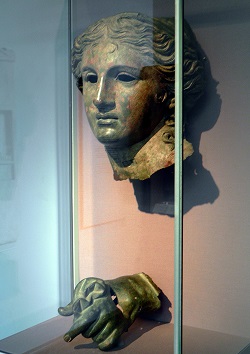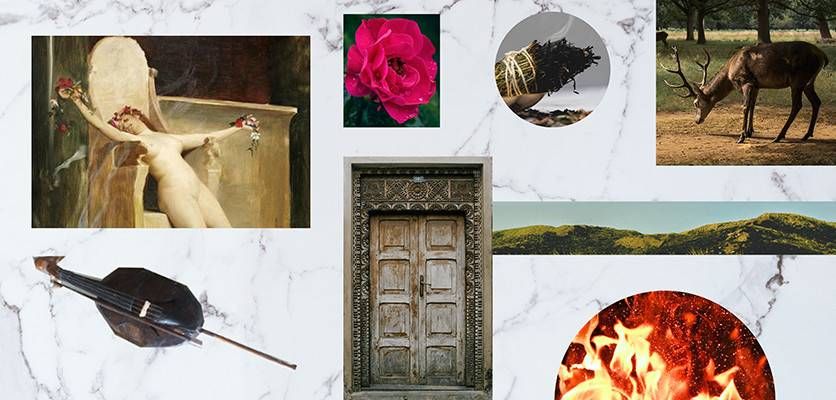Navasard: Our old New Year made new
August 11, 2021
Did you know that Navasard is one of the top growing queries on Google that lead to h-pem? While you may be surprised to hear our “11 facts” plays a key role in demystifying one of the most obscure pre-Christian festivals, be sure to read our exclusive piece by Hratch Demiurge on the ancient Armenian New Year—his “funny” take comes with a crescendo of poetic delights!
Hratch Demiurge, comedian, poet, teacher and translator of Daniel Varoujan's Pagan Songs has generously granted h-pem the right to publish his English translation of Navasardian aghotk ar ditsouhin Anahit (“Նաւասարդեան աղօթք առ Դիցուհին Ահահիտ” | “Navasardian Prayer to the Goddess Anahit”)—Siamanto’s soulful prayer to the “golden-footed” deity who presided over the annual festivities of the month Navasard. You can find it at the end of the article below.
It always struck me as strange that we celebrate New Year’s Day on December 31st in the dead of winter when nature is old and dead. It’s like celebrating someone’s birthday a month after their funeral.
I later learned that the reason for this is the winter solstice when the sun is at its lowest point in the sky, after which the sun is “reborn” and begins its journey back to its apex in the summer solstice.
But this struck me as no less strange. It would be like celebrating a person’s birthday not starting when they exit their mother’s womb and come into the light of the world, but beginning that obscure night that their parents fumbled around in the dark and had to wash the sheets the next morning. Technically, that’s when you began, yes, but it doesn’t mean that’s the day you want to celebrate! You’d rather never be reminded of that day…
Spring always seemed to me a much more appropriate time to celebrate the start of the New Year, you know, when everything is new, when the sun shines down on the newborn flowers and the shameless trees start putting their clothes back on.
When I later learned that our ancestors shared this crazy idea, I felt vindicated. For, according to the old Armenian calendar, the first month of the year was called Navasard, which etymologically means “New Year,” and it indeed was found at the beginning of spring. But the adoption of the Julian calendar threw everything off, Navasard was moved to summertime for some reason, and the first month of the new New Year became old, cold, miserable January.
This is why the Navasardian games in Los Angeles take place in the summer. But the Los Angeles Navasardian games have been moved to coincide with the 4th of July weekend and American Independence Day instead of its original summer date of August 11-September 9. This is probably what happened hundreds of years ago that shifted Navasard from spring to summer to begin with, that is, having to adapt to the schedule of more powerful foreign nations. And so poor Navasard continues to drift like wreckage on the sea, tossed here and there. One day it’ll find itself in the dead of winter and things will come full circle.
The original Navasard in ancient Armenia, like the Olympic games in ancient Greece, was a religious holiday devoted to the gods. But also like the current Olympics games, Navasard now is a hollow shell of its former self, a sham detached from its original significance. When the solemnity of the badarak (պատարագ | mass) is taken away, all it becomes is a bread line. Vardavar was originally a ritual that took place during Navasard: when its sanctity was taken away, it became a mere water fight instead of a magical fertility ritual.
.jpeg) Pagan Songs («Հեթանոս երգեր» | “Hetanos Yerger”) is the first full, uncensored English translation of a once taboo masterpiece.
Pagan Songs («Հեթանոս երգեր» | “Hetanos Yerger”) is the first full, uncensored English translation of a once taboo masterpiece.With the pagan movement in literature, which started in 1912 with the publication of Daniel Varoujan’s Pagan Songs («Հեթանոս երգեր» | “Hetanos Yerger”), an attempt was made to return the magic to Navasard. In 1914, Varoujan and Hagop Sirouni started a literary journal called Navasard with Varoujan contributing a short poem appropriately titled “Navasardian:”
Spirit of Armenia, at these Navasardian festivities
Bright as the sun,
May you be reborn from the ruins, and thy laudatory
Lyre take up.
In the name of Strength, in the name of Beauty, enter the temple
Of the gods—
Torch in hand, from the entrance to the altar scatter
Fire and blood.
And raise all the way up to Anahit’s breasts
Your crimson cup—
Then upon the hearts of suffering poets
Pour! Pour!
For we, in the name of the Love and Seed of your ancient Race,
Virgin of marble,
We, your august Children, will magnificently make
A New Daybreak!
In the same year Siamanto joined the pagan movement with his own even more elaborate and forceful poem “Navasardian Prayer to the Goddess Anahit.” The poem speaks for itself, but its uncompromising enmity toward the current religion of Armenia is noteworthy. It’s referred to in the very first line as “an enervating religion.” Harsher still, the speaker breaks the two “poisonous” arms of a cross and throws them into the fire of the goddess Anahit’s altar. A “diseased” bone from one of the ribs of Gregory the Illuminator is sacrificed in the flames as revenge, since it was the foreigner Gregory who had Anahit’s temple destroyed. Finally, the speaker of the poem begs Anahit to fumble around in the dark with the sun and give birth to a terrible, war-like, invincible god to save Armenia from extermination.
However, this god was never born and, like our present New Year in January, the year after 1914 proved a time of death for both Varoujan and Siamanto. But their sun is merely at its lowest point and will one day rise up again. The Navasardian Prayer to the Goddess Anahit is a passionate plea for a new springtime in Armenia and to return the magic to Navasard.
Navasardian Prayer to the Goddess Anahit
By Siamanto
Translated by Hratch Demiurge
 Head and left hand from a bronze cult statue of Anahit (Photo: Wikimedia Commons)
Head and left hand from a bronze cult statue of Anahit (Photo: Wikimedia Commons)
O Goddess, I have washed my conscience of the enervating religions
And confidently walk toward thee. My sandals are still sacred.
Open the marble door of thy temple; let me paint your forehead with blood...
Open thine altar and give me the blond brawn of my Artaxian [1] ancestors...
Hear me, Golden Mother, [2] Sister of fertility, Sister of goodness,
Bestower of plenty and Mistress of ancient Armenians:
On Navasardian morn, behold, Thy former race rejoices...
Allow me to pray upon my knees before thine image...
Hear me, Miraculous Rose, golden-footed goddess,
White Bride of the night [3] and Lover of the Sun,
And lustrous nudity of the Aramazdean [4] Marriage Bed:
May the sun with a single ray reignite thine altar.
I believe in Thee. Standing on the hills of Bagrevand, [5]
I, a heathen of many centuries and a spear-bearing son of thine,
As an apostle and suppliant I come to Thee with head held high—
Hear me, my Armenian bambir [6] is born from Goghtn [7] soil!
I come on a mission. Clothed in a chlamys [8] and a bundle of fresh barsom-sticks [9] in hand,
Behold, a silver watering can full of rosewater to anoint thy breasts...
Behold, a censer shaped like a vase, where I cried my tears at thy destruction...
And with sacrificial deer following my shadow, I walk toward Thee...
From the hills of Bagrevand may pagan life flow,
Statuesque children of the sun, robed in byssus. [10]
After training with bow, spear and arrow, on the threshold of thy sacrificial altar,
Let them stick their swords into the necks of the stout oxen...
Let a pure flock of turtledoves from the shoulders of ripened Armenian brides
Fly toward thy statue. Let the water-fight of Vardavar [11] commence!
And sixteen-year old maidens circle-dancing around thine altar,
O Our Lady of chastity, may they give their magical bodies to thee.
Let me exact Thy revenge of twenty centuries today,
O thou goddess Anahit! Behold, I threw into the flames of thine altar
My shattered wooden cross’s two poisonous arms;
And rejoice, O Golden Mother, as I burn one of the Illuminator’s [12] diseased rib-bones for thee…
I beg of Thee, O Thou powerful, unparalleled Beauty...
Thou, by giving Thy body to the sun, be impregnated by its Element,
And an invincible, fearsome God bestow on the Armenian people...
From thy diamond womb, for us, O Goddess, give birth to a fearsome God!
FOOTNOTES
[1] The classical Greek spelling of the Armenian king Artashes. Artashes I was the founder of the illustrious Artashesian (Artaxian) dynasty at the start of the 2nd century B.C. with permission from Rome. A tradition preserved by Plutarch and Strabo held that it was the great Carthaginian general Hannibal who helped Artashes establish what became the capital of Armenia, Artaxata (Artashat). Armenia’s most illustrious king, Tigranes the Great, was a member of this royal dynasty.
[2] Anahit’s statue was the first in recorded history to be made out of solid gold according to the Roman encyclopedist Pliny the Elder. This statue was eventually plundered by soldiers in the army of the drunken scoundrel Marcus Antonius. Pliny relates an anecdote about a soldier who became fabulously wealthy just from selling one of the statue’s solid gold legs. Cf. Natural History, Book XXXIII, chapter 24, page 105, Volume 6, translated by John Bostock and H.T. Riley).
[3] i.e., the moon. Compare Varoujan’s “Anahit” for her association with the moon.
[4] Aramazd is the chief god of the pantheon, father of Anahit.
[5] Bagrevand, a province of Greater Armenia and site of pre-Christian royal tombs. Located in the southeast of this province was one of the most important religious centers in pagan Armenia called Bagavan, which literally means “city of altars,” and not as Christian whitewashing has it, “city of idols.” The New Year’s festival on the first day of the month of Navasard was celebrated by the royal family at Bagavan. See Agathangelos chapter 836 and the Encyclopaedia Iranica article “Bagawan (2)” by R.H. Hewsen. See also Movses Khorenatsi II. 66.
[6] A traditional three stringed musical instrument related to the lute and guitar.
[7] A district located in the province of Vaspurakan in historical Armenia notable as the birthplace of a number of prominent Armenian gusans, or bards.
[8] In ancient Greece, a short military cloak worn over the shoulder. In the Byzantine period, it was worn in a longer form by high officials and emperors.
[9] A bundle of baresman (or barsom) twigs were used by the Magi in religious ceremonies. The Hellenistic Armenian king Antiochus I Theos of Commagene in one relief is depicted shaking hands with the sun god Mithra with baresman sticks in hand.
[10] A rare fabric also known as sea-silk.
[11] A pagan Armenian festival in which participants drench one another with water. As James Frazier explains, it was an exercise in sympathetic magic to ensure rainfall and has parallels in many other native traditions. The festival was coopted by the Christian Church and is now supposed to celebrate the transfiguration of Jesus.
[12] i.e., St. Gregory the Illuminator, responsible for the conversion of the Armenian state religion to Christianity in 301 AD.
Pagan Songs is available on Amazon and at Armenian bookstores across the U.S., including Sardarabad and Abril in Glendale!
Check out Hratch Demiurge's newly established online journal breadandonions.com for philosophy-packed satire.
Join our community and receive regular updates!
Join now!




Attention!